Abstract
In Russia, successful development of horse breeds with a global gene pool requires the use of foreign high-quality breeding products, since in conditions of fierce competition it is necessary to produce a competitive high-quality product that can be sold both at domestic and international markets. The aim of the work is to analyze the dynamics of imports of breeding horses, sperm materials and embryos into the territory of the Russian Federation for 2016-2019, as well as to assess the effectiveness of this measure to increase the competitiveness of domestic breeding products in the context of import substitution. The scientific novelty of the research is due to the comparative analysis of the structure and efficiency of the imports of breeding products and sperm material into the territory of Russia for 2016-2019. The research results have shown the effectiveness of imports of foreign breeding horses and semen products aimed at replenishing the domestic breeding base with valuable genetic resources.
Keywords: Import of breeding horses, rating, sperm production, selection
Introduction
Imports are essential for the economy. Countries import goods that they do not produce. The import policy should contribute to the development of domestic production, create a competitive environment that encourages domestic producers to reduce production costs, improve product quality, which helps to increase the efficiency of the national economy (Dudin & Omarova, 2019).
In livestock breeding, the import of productive livestock breeds plays a significant role in the development of new breeds of farm animals adapted to the Russian conditions. Through the active import of Western breeds and crosses, as well as technologies, the Russian poultry and pig breeding managed to conquer the domestic market, and the largest milk producers purchase Holstein from Europe and America because of the high milk yield potential (Suleimanov et al., 2020).
According to Sharkaeva, the breeding of highly productive domestic breeds is the most reliable and correct way; however, even with the use of modern biotechnological methods, the result can be obtained in the long run (as cited in Adamkovskaya et al., 2018; Kalinkina et al., 2018; Uskov & Tsopanova, 2016).
The successful development of horse breeds with a global gene pool requires foreign high-quality breeding products, since the lag of Russian horses does not allow the country's horse breeding to reach a new level of development and become competitive (Khrabrova et al., 2019; Kalashnikov et al., 2011).
In order to increase the genetic potential of the domestic breeding, increase the number of highly productive animals, the Ministry of Agriculture of Russia in 2016 restored the zero VAT rate for the import of breeding materials (animals, sperm of producers, embryos). In this regard, the study of the issues of import of pedigree products into the territory of the Russian Federation and the dependence of the development of domestic pedigree horse breeding on imports is of particular relevance and practical importance.
The purpose is to provide an analytical review of statistical information on the import of breeding horses, semen (sperm) obtained from breeding stallions and study the effectiveness of tax benefits for the import of breeding material.
Problem Statement
In 2016, in Russia government measure was implemented to restore the zero VAT rate on the import of breeding animals and breeding material (producer's seed, embryos) into the country. This measure was designed to help replenish the breeding base with highly productive livestock of farm animals, including horses, to meet the growing needs of businesses for valuable genetic material, and the target audience of the equestrian industry for promising horses for running and racing.
To what extent the measure was effective is the main question of this study.
Research Questions
The subject of research is the dynamics and structural analysis of the import of breeding horses to Russia.
- Structure of the leading exporting countries.
- Regional import structure.
- Dynamics of species composition of imported livestock.
Purpose of the Study
The aim of the work is to analyze imports in the breeding horse breeding of the Russian Federation for the period from 2016 to 2019, as well as to assess the effectiveness of using imported sperm and embryos to increase the competitiveness of domestic breeding products.
Research Methods
The research material was data of the centralized pedigree registration database of the All-Russian Research Institute of Horse Breeding on the number of imported horses, results of pedigree use and testing.
The object was the import of pedigree products and materials into the Russian Federation, and test results at racetracks of Russia for 2016-2019.
The research results were processed in Microsoft Office Excel 2010.
Findings
For 2016 to 2019, the total volume of pedigree horses imported to Russia amounted to 575 heads. The share of stallions in the import structure accounted for 7.3%, of mares - 28.7% and of young animals - 64.0% (Figure 01).
The import of breeding horses to Russia has a wave-like character, following the state of economic well-being of the population.
In 2019, there was a sharp increase in the imports of pedigree young animals up to 176 heads, which amounted to 76.2% of the total annual imports of pedigree horses to Russia.
A significant part of breeding horses was imported to the North Caucasus (44%), and South (20%) and Central (18%) federal districts. The Siberian FD accounts for only 4% (Figure 02).
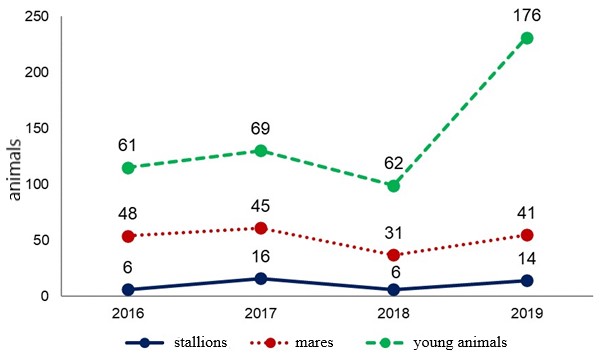
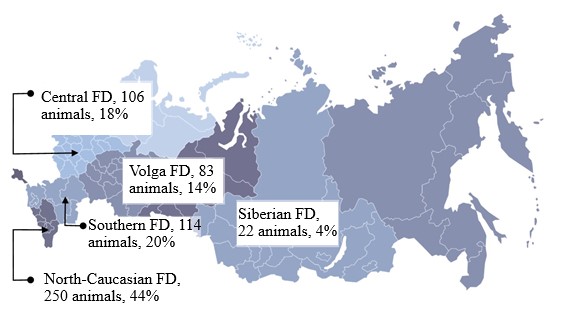
As can be seen from Table 01, the number of imported purebred horses increased in 2019. This is due to regular prestigious prizes with a multi-million dollar prize fund (Prize of the President of the Russian Federation, Prize of the Minister of Agriculture of Russia, personal prizes).
Trotter breeding ranks second by the number of imported horses. However, in this sector, a negative dynamics of imports can be traced throughout the entire study period. Underdeveloped sweepstakes, a limited number of expensive and prestigious prizes, small prizes, expensive maintenance, and a decrease in the number of trotters tested are the reasons for the import recession in the domestic trotting horse breeding.
The import of valuable breeds is due to the supply of horses from leading horse breeding countries. In 2016-2019, the main horse exporting countries were: USA, Sweden, and France (Figure 03).
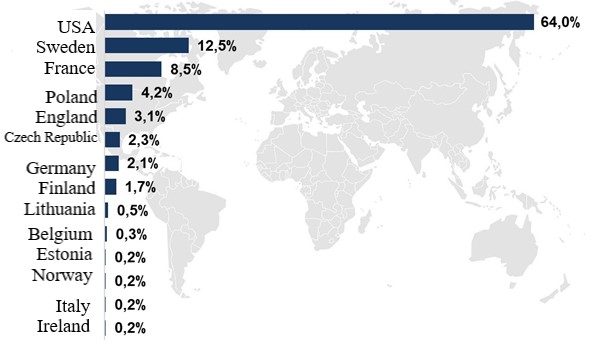
American and French trotters are exported from nine countries (Table 02). 72 heads (or 46.8%) were imported from Sweden.
Thoroughbred horse breed ranks second (7 countries export this breed). The largest number of horses of this breed was imported from the USA - 329 heads (or 89.6%) and only a small part (5.2%) - from Europe.
Purebred Arabian horses were mainly imported from Poland (84.6%) and France (15.4%). In general, France has the largest range of breeds imported to Russia - 4 out of 6 breeds.
Out of 5 exporting countries (Ireland, Italy, Norway, Estonia and Belgium), only 1-2 heads of pedigree horses were brought to Russia (mainly American and French trotting breeds).
In recent years, 95-99% of the imported young horses are purchased by hippodromes (Figure 04).
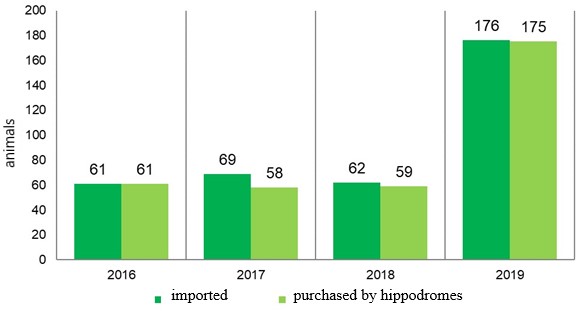
Of the trotters imported into the Russian Federation in 2016-2019, 67 heads were tested at the hippodromes. The average agility at a distance of 1600 meters was 2.04.2, the similar indicator of domestic breeding trotters aged 3 years and older was 2.08.5.
For 2016-2019, 47 All-Russian records for horses were registered at the racetracks of the Russian Federation, 45 of them were set by trotters born from imported parents, including 21 obtained with imported semen.
Table 03 shows the results of performances of thoroughbred horses.
Note: *The table contains data on performances of horses imported in the report year and imported earlier.
These tables allow us to see a significant superiority of the imported young purebred horses over domestic peers by their performance at hippodromes. They often become winners of traditional prizes. Foreign racehorses have won 307 times, which is 42% higher than their Russian peers.
Import of purebred riding horses changes their genealogical structure. The dominant role is assigned to the most widespread lines in the world purebred horse breeding: Nortern Dancer, Native Dancer, Nazrullah and Nearko. The increase in linear diversity provides the breed with breeding resources due to the approbation of new genealogical complexes.
A comparative analysis of the genetic characteristics of domestic and imported purebred horses based on the DNA microsatellites loci showed that imported stallions and mares had a higher level of polymorphism, which maximizes the effectiveness of control over the origin of animals.
As a rule, imported stallions and mares have a high breeding value, a valuable origin, are representatives of the most widespread lines, come from stallions that rank high in the world ranking of the best producers, have a high level development of breeding traits.
Most of them are used for breeding purposes. Out of 42 stallions and 165 mares imported, 29 stallions and 161 mares received breeding assignment, which is 69.0% and 97.6%, respectively (Figures 05 and 06). The use of imported breeding materials contributes to the high breeding effect. For example, the imported dark chestnut purebred Arabian stallion Chimeric (Eriks - Chimera), born in 2008 in one of the leading Arab stud farms in Poland, was equal to expectations. To date, he gave 36 descendants, including gold and silver medalists of show championships. One more example is Corvinius (Rainbow Quest (USA) - Cristal Ring (IRE), a purebred chestnut stallion imported from Germany, which gave the animal yield in the amount of 193 heads, 68 of which are highly rated for origin and race class.
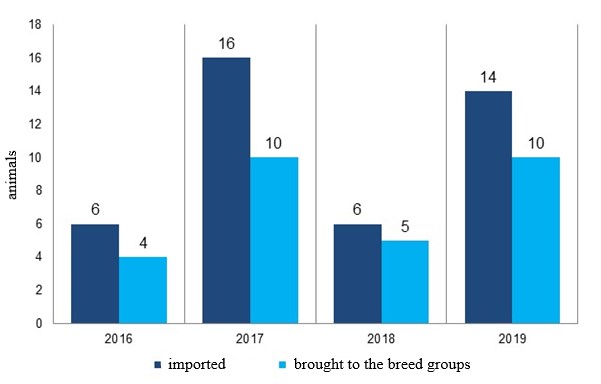
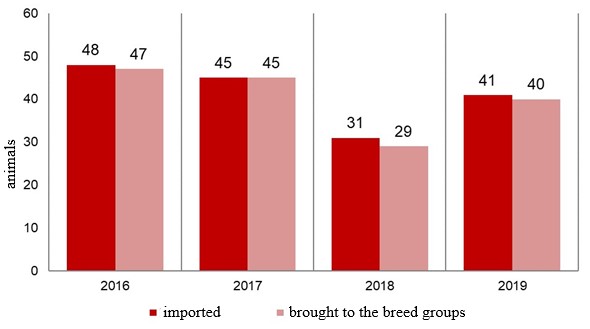
In the last three years, representatives of heavy-harness horse breeds feel confident in this direction.
Thus, due to the stallions and mares of the Percheron breed imported from France, in Saratov region a pedigree reproducer has been created.
The stallions of the Lithuanian heavy-harness breed brought from Lithuania have joined the production staff of ZAO PKZ "Semenovsky", located in the Republic of Mari El, specializing in breeding horses of this breed for the production of kumis. The breeding is aimed at increasing the milk productivity of mares.
Sports horses are imported from Western Europe for equestrian sports, leisure, recreation and entertainment. However, it was not possible to analyze this direction of the pedigree market due to the lack of reliable statistical data.
The supply of imported sperm products turned out to be insignificant; the import of semen from trotting stallions was registered. In 2016, 242 doses were imported from 12 breeding stallions, 68 foals were received; in 2017, 24 doses from 8 stallions were imported, and 15 foals were received. In 2018 and 2019, 50 doses from 5 breeding stallions were imported, and 10 foals were born.
Small volumes of imported sperm are due to the organizational and economic factors. Among the organizational factors, one can mention a significant shortage of breeding centers and qualified personnel for artificial insemination of mares.
Economic reasons are high prices that Russian buyers must pay to a foreign seller for foals born from mares inseminated with imported sperm. The amount of payment depends on the stallion's place in the world ranking of producers and can vary from 3500 to 21000 US dollars.
According to Dudin and Omarova (2019), the high exchange rate and anti-Russian sanctions have a high impact on the import of high-quality breeding products.
Some exporting countries are not interested in exporting high-quality breeding stock, as this may create competitors.
The method of embryo transplantation, put into practice in the 1980s by the specialists of the All-Union Research Institute of Horse Breeding, has not found wide application in domestic horse breeding. Among the main factors hindering the development of the embryo transplantation are the low level of innovation and high costs of breeding materials.
Conclusion
Import of breeding horses and semen is an effective measure contributing to the replenishment of the breeding base with valuable genetic resources.
An analysis of the structure of the horse population imported to Russia revealed a pattern in the predominant import of thoroughbred horse, American and French trotting breeds. There is stable dependence on foreign breeding materials. The endless choice of breeding horses in the global trotting and thoroughbred horse breeding industry stimulates the need to import more valuable genetic resources.
The breeding horses are imported from the USA, Sweden, and France. At the same time, the import of breeding material remains less developed.
The sustainable growth in the import of high-quality sperm and embryos requires modern selection and breeding centers. It is necessary to raise the level of innovative and technical equipment in the industry. For the successful development of this segment, it is important to train professionals and raise the level of knowledge among practitioners.
Despite the positive impact of imported pedigree products on the development of domestic horse breeding, one should not forget that import substitution is one of the priority tasks of the Russian agro-industrial complex, an important factor in ensuring national security.
Today, the activities of domestic horse breeding should be aimed at creating national producing centers whose products would be competitive and enjoy a steady, growing demand. To achieve this goal and avoid imports dependence, it is necessary to mobilize the entire innovative potential of the industry, carry out large-scale technical and technological modernization, develop the breeding industry, and create a domestic competitive base for horse breeding. It is necessary to apply measures of state regulation of the horse breeding market, as well as protectionist measures in relation to domestic horse breeding, and create a number of preferences for horses born in Russia.
Acknowledgments
The authors are grateful to the Selection Department of the All-Russian Research Institute of Horse Breeding for the materials provided for the study.
References
Adamkovskaya, M. V., Vikulova, L. L., Aydarov, V. A., & Safronova, S. N. (2018). Monitoring of the current state of uterine families in purebred riding breed.Achievements of young scientists - zootechnical science and practice: collection of articles. scientific. reports (pp. 40-45) Divovo.
Dudin, M. N., & Omarova, Z. K. (2019). Import substitution in the agro-industrial complex as a strategic direction for ensuring national security. TsITISE, 2(19), 7-10.
Kalashnikov, R. V., Zaitsev, A. M., Koveshnikov, V. S., & Kalashnikov, V. V. (2011). Market of breeding horses in Russia.Horse breeding and equestrian sport, 6, 3-7.
Kalinkina, G. V., Kreshikhina, V. V., Tsopanova, A. V., & Uskov, G. E. (2018). Distance abilities of the Orlov trotter due to mutations in the MSTN gene. Chief zootechnician, 10, 10-17.
Khrabrova, L. A., Blohina, N. V., Suleymanov, O. I., Rozhdestvenskaya, G. A., & Pustovoy, V. F. (2019). Assessment of line differentiation in the Thoroughbred horse breed using DNA microsatellite loci. Vavilov Journal of Genetic and Breeding, 23(5), 569-574. DOI:
Suleimanov, O. I., Adamkovskaya, M. V., & Safronova, S. N. (2020). Changes in the structure of the producing composition of the thoroughbred horse breed of horses in Russia. Horse breeding and equestrian sport, 2, 7-10. DOI:
Uskov, G. E., & Tsopanova, A. V. (2016). The use of the stud-horses’ evaluation by the quality of progeny in Budyonny horse breeding. Advances in Agricultural and Biological Sciences, 2(6), 39-46.
Copyright information

This work is licensed under a Creative Commons Attribution-NonCommercial-NoDerivatives 4.0 International License.
About this article
Publication Date
01 July 2021
Article Doi
eBook ISBN
978-1-80296-112-6
Publisher
European Publisher
Volume
113
Print ISBN (optional)
-
Edition Number
1st Edition
Pages
1-944
Subjects
Land economy, land planning, rural development, resource management, real estates, agricultural policies
Cite this article as:
Kalinkina, G. V., Dubrovin, A. V., Tsopanova, A. V., & Uskov, G. E. (2021). Imports Development Trends In The Russian Horse Breeding Sector. In D. S. Nardin, O. V. Stepanova, & V. V. Kuznetsova (Eds.), Land Economy and Rural Studies Essentials, vol 113. European Proceedings of Social and Behavioural Sciences (pp. 35-44). European Publisher. https://doi.org/10.15405/epsbs.2021.07.5

